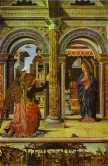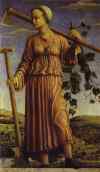Francesco del Cossa Biography
Together with Cosmè Tura
and Ercole de’Roberti, Francesco del Cossa belonged to the great trio of the Ferrara school of painting. Cosmè Tura’s assistant and partner in Ferrara, Cossa reduced his master's austerity in his own more genial style of painting. Although less fantastic in temperament than Tura, it is sometimes difficult to distinguish one from the other. Very possibly Donatello’s work in Padua also played an important role in formulating the young painter's style.
In the 1460s, Cossa collaborated with Tura on the most important project of the Early Renaissance in Ferrara: the decoration of the Sala dei Mesi (The Hall of the Months) in the Palazzo Schifanoia. Although only fragments of it survive, Cossa’s contribution depicting the months of March, April and May remain in good condition. His masterpieces are the allegories of the Months that he painted for the salon in the Schifanoia Palace in Ferrara (c. 1470). Here he combined mythological scenes and astrological references with episodes from contemporary life of the Duke, the city, and the countryside.
Dissatisfied with the financial and moral rewards he was receiving, Cossa left Ferrara and settled in Bologna just after 1470. There he painted major altarpieces (Merchant's Altarpiece, Bologna, Galleria Nazionale; Annunciation, Dresden) and for the church of San Petronio he produced the ambitious Grifoni Polyptych. He died in Bologna in 1477/78.
Palazzo Schifanoia belonged to the Ferrara dynasty of d’Este. Its construction started in 1391, during the period of 1450-1470 it was significantly rebuilt. The program for the decoration of the large banqueting hall, called the Hall of the Months, was worked out by Pellegrino Prisciani, a professor of astrology.
Twelve fields, extending from a painted pedestal right up to the ceiling, were each assigned to one month of the year. Each field is divided horizontally into three zones. The top zones show the astrological rulers of the month in triumphal procession. The narrower middle zones feature the signs of the zodiac and astrological demons. Finally, the bottom zones – twice as high as the middle fields – are devoted to a scene from court life linked to the month in question.
The cycle was carried out by Francesco del Cossa and Cosmè Tura between 1460 and 1470. Only the frescos on the east wall, showing March, April and May, have survived relatively intact. They mark the summit of Cossa’s artistic development.
Bibliography
Monumental Painting of Italian Renaissance. by I. Smirnova. Moscow. 1987.
The Art of the Italian Renaissance. Architecture. Sculpture. Painting. Drawing. Könemann. 1995.
Painting of Europe. XIII-XX centuries. Encyclopedic Dictionary. Moscow. Iskusstvo. 1999.
- Annunciation.

Tempera on poplar panel. 27.5 x 44 cm. Alte Meister Gallerie, Dresden, Germany. Read Note.
- The Muse Polyhymnia.

c.1450. Canvas, transferred from panel. 166.5 x 71 cm. Gemäldegalerie, Berlin, Germany. Read Note.